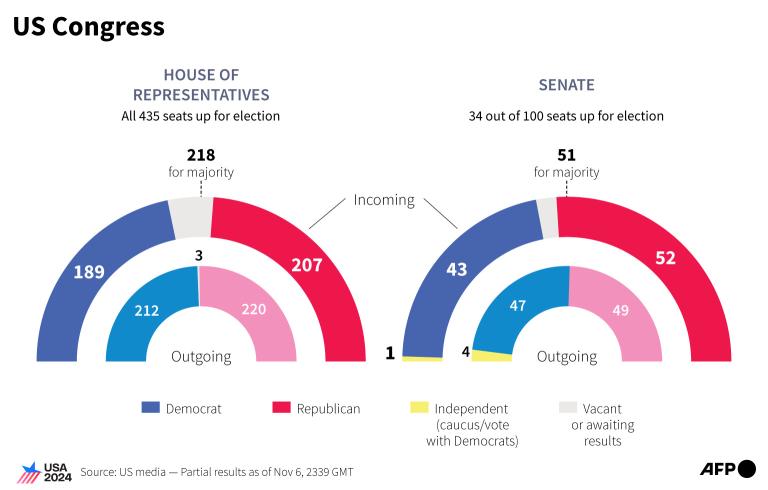
WASHINGTON - Republicans won control of the US Senate with victories in West Virginia and Ohio on Tuesday, ensuring Donald Trump's's party will control at least one chamber of Congress next year.
Republicans also posted early gains as they battled to retain control of the House of Representatives.
If they prevail, Republicans would be in a position to dictate the agenda in Washington, helping Trump deliver on his promise to slash taxes and restrict immigration.
The final result will probably not be known for days, but Tuesday's results ensured Republicans in the Senate would be able to help Trump appoint conservative judges and other government personnel.
Republican West Virginia Governor Jim Justice was projected to win an open Senate seat in the state shortly after polls closed, taking over the seat previously held by Joe Manchin, a Democrat-turned-independent. In Ohio, Republican Bernie Moreno was projected to defeat third-term incumbent Democrat Sherrod Brown. Those two victories ensured Republicans will hold at least a 51-49 majority in the Senate.
Republicans stood a chance to widen their Senate majority further, as their candidates were leading Democratic incumbents in Michigan, Montana, Pennsylvania, Nevada and Wisconsin.
Republican incumbents also held off challengers in Texas, where Ted Cruz won reelection, and Nebraska, where Deb Fischer defeated independent Dan Osborn.
However, they were unlikely to end up with the 60-vote majority needed to advance most legislation in the chamber.
ALSO READ: Amid fears of violence, US voters head to polls as turbulent campaign concludes
The Senate was set to see two Black women serving simultaneously for the first time, as Democrat Lisa Blunt Rochester won in Delaware, and Democrat Angela Alsobrooks won in Maryland.

House up for grabs
Republicans also won several races that could allow them to expand their 220-212 majority in the House, though the final outcome may not be known for days.
They won a Democratic-held district in Pennsylvania that includes Scranton, Democratic President Joe Biden's hometown, and picked up seats from Democrats in North Carolina, where they had redrawn district lines to their advantage, with another victory in Michigan.
Democrats won a Republican-held seat in upstate New York and a seat in Alabama that had been redrawn to comply with a US Supreme Court order to create a Black majority district.
Democrats now need to flip at least seven seats to take control of the 435-seat chamber. But their opportunities to do so were gradually diminishing, as Republican incumbents won competitive reelection races in Colorado, Iowa, New Jersey and Virginia.
In Delaware, voters made history by electing Democrat Sarah McBride, the first openly transgender member of Congress.
READ MORE: US states worried about election unrest take security precautions
With at least 200 seats safe for each party, the winning side will likely end up with a narrow majority that could make governing difficult. That has been evident in the past two years as Republican infighting has led to failed votes and leadership turmoil and undercut the party's efforts to cut spending and tighten immigration.
Tight races in the heavily Democratic states of New York and California could determine House control, and California typically takes several days to count its ballots.


